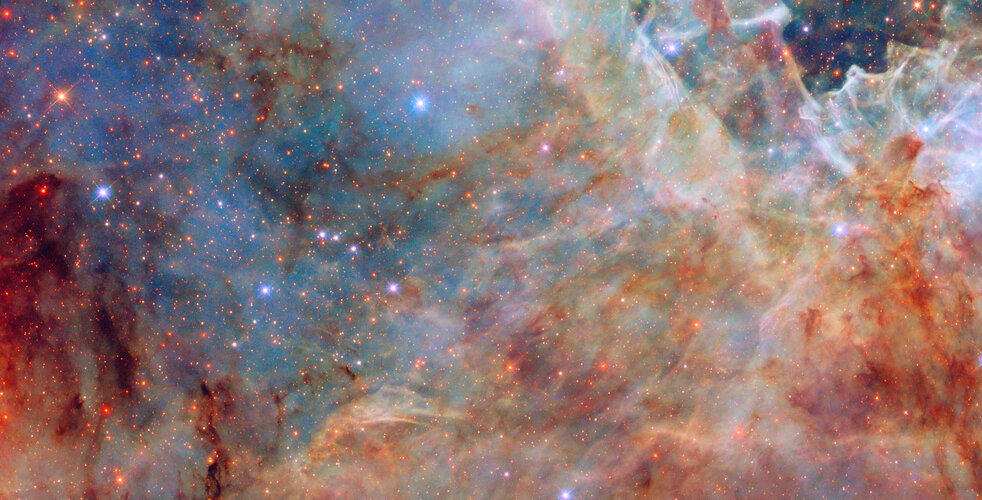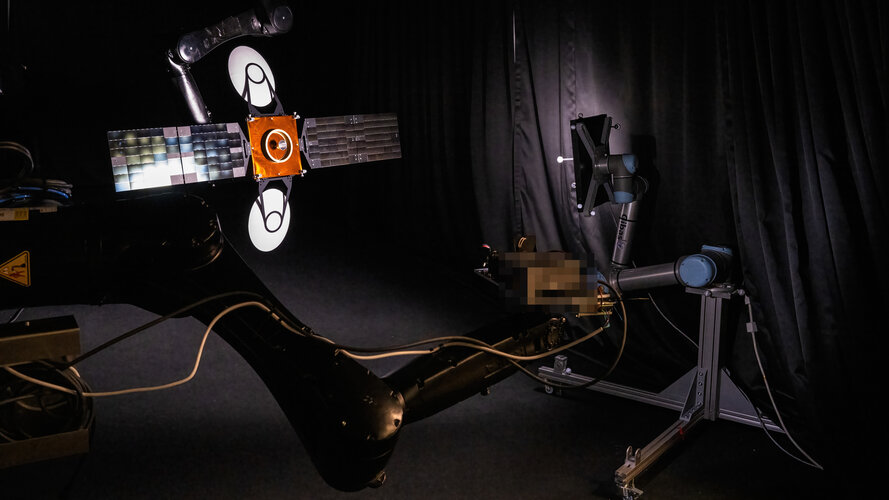
Copernical Team
Friday, 24 January 2025 10:43
Now That's Ingenuity: First Aircraft Measurement of Winds on Another Planet
Washington DC (SPX) Jan 23, 2025
 Researchers have used an aircraft to measure the wind speed on Mars, marking the first time this method has been used on another planet. This groundbreaking measurement was made possible by the Ingenuity helicopter, which was active for nearly three years and spent, cumulatively, more than two hours in flight on the Red Planet.
In February 2021, Mars got two new inhabitants: the Perseveran
Researchers have used an aircraft to measure the wind speed on Mars, marking the first time this method has been used on another planet. This groundbreaking measurement was made possible by the Ingenuity helicopter, which was active for nearly three years and spent, cumulatively, more than two hours in flight on the Red Planet.
In February 2021, Mars got two new inhabitants: the Perseveran
 Researchers have used an aircraft to measure the wind speed on Mars, marking the first time this method has been used on another planet. This groundbreaking measurement was made possible by the Ingenuity helicopter, which was active for nearly three years and spent, cumulatively, more than two hours in flight on the Red Planet.
In February 2021, Mars got two new inhabitants: the Perseveran
Researchers have used an aircraft to measure the wind speed on Mars, marking the first time this method has been used on another planet. This groundbreaking measurement was made possible by the Ingenuity helicopter, which was active for nearly three years and spent, cumulatively, more than two hours in flight on the Red Planet.
In February 2021, Mars got two new inhabitants: the Perseveran
Published in
News
Tagged under
Friday, 24 January 2025 10:43
Major component of NASA's NEO Surveyor enters deep space testing
Los Angeles CA (SPX) Jan 23, 2025
 A critical component of NASA's Near-Earth Object (NEO) Surveyor mission has begun a rigorous testing phase at the Johnson Space Center in Houston. Known as the instrument enclosure, the structure spans 12 feet (3.7 meters) in length and is designed to safeguard the spacecraft's infrared telescope while efficiently dissipating heat during its operations in space.
Built by NASA's Jet Propuls
A critical component of NASA's Near-Earth Object (NEO) Surveyor mission has begun a rigorous testing phase at the Johnson Space Center in Houston. Known as the instrument enclosure, the structure spans 12 feet (3.7 meters) in length and is designed to safeguard the spacecraft's infrared telescope while efficiently dissipating heat during its operations in space.
Built by NASA's Jet Propuls
 A critical component of NASA's Near-Earth Object (NEO) Surveyor mission has begun a rigorous testing phase at the Johnson Space Center in Houston. Known as the instrument enclosure, the structure spans 12 feet (3.7 meters) in length and is designed to safeguard the spacecraft's infrared telescope while efficiently dissipating heat during its operations in space.
Built by NASA's Jet Propuls
A critical component of NASA's Near-Earth Object (NEO) Surveyor mission has begun a rigorous testing phase at the Johnson Space Center in Houston. Known as the instrument enclosure, the structure spans 12 feet (3.7 meters) in length and is designed to safeguard the spacecraft's infrared telescope while efficiently dissipating heat during its operations in space.
Built by NASA's Jet Propuls
Published in
News
Tagged under
Friday, 24 January 2025 10:43
Study suggests small asteroid 2024 PT5 likely originated from the Moon
Los Angeles CA (SPX) Jan 23, 2025
 The near-Earth object 2024 PT5, a small asteroid discovered in 2024, has been identified as likely originating from the Moon. Scientists believe it was ejected into space thousands of years ago following a significant impact event, offering valuable opportunities to study both asteroid dynamics and lunar geology.
The asteroid, approximately 33 feet (10 meters) wide, was first observed on A
The near-Earth object 2024 PT5, a small asteroid discovered in 2024, has been identified as likely originating from the Moon. Scientists believe it was ejected into space thousands of years ago following a significant impact event, offering valuable opportunities to study both asteroid dynamics and lunar geology.
The asteroid, approximately 33 feet (10 meters) wide, was first observed on A
 The near-Earth object 2024 PT5, a small asteroid discovered in 2024, has been identified as likely originating from the Moon. Scientists believe it was ejected into space thousands of years ago following a significant impact event, offering valuable opportunities to study both asteroid dynamics and lunar geology.
The asteroid, approximately 33 feet (10 meters) wide, was first observed on A
The near-Earth object 2024 PT5, a small asteroid discovered in 2024, has been identified as likely originating from the Moon. Scientists believe it was ejected into space thousands of years ago following a significant impact event, offering valuable opportunities to study both asteroid dynamics and lunar geology.
The asteroid, approximately 33 feet (10 meters) wide, was first observed on A
Published in
News
Tagged under
Friday, 24 January 2025 08:49
A Tarantula’s outskirts
 Image:
A Tarantula’s outskirts
Image:
A Tarantula’s outskirts
Published in
News
Tagged under
Friday, 24 January 2025 12:25
Satellite ready for close-up
 Image:
Satellite ready for close-up
Image:
Satellite ready for close-up
Published in
News
Tagged under
Friday, 24 January 2025 12:56
Week in images: 20-24 January 2025

Week in images: 20-24 January 2025
Discover our week through the lens
Published in
News
Tagged under
Friday, 24 January 2025 14:00
The sounds of BepiColombo's sixth flight past Mercury
 Video:
00:01:20
Video:
00:01:20
Listen to the ESA/JAXA BepiColombo spacecraft as it flew past Mercury on 8 January 2025. This sixth and final flyby used the little planet's gravity to steer the spacecraft on course for entering orbit around Mercury in 2026.
What you can hear in the sonification soundtrack of this video are real spacecraft vibrations measured by the Italian Spring Accelerometer (ISA) instrument. The accelerometer data have been shifted in frequency to make them audible to human ears – one hour of measurements have been sped up to one minute of sound.
BepiColombo is always shaking ever so
Published in
News
Tagged under
Thursday, 23 January 2025 09:11
Bright Ascension software powers Czech Republic's largest satellite mission
Los Angeles CA (SPX) Jan 21, 2025
 Bright Ascension Ltd., a leading provider of space software technology, has announced the successful deployment of its software aboard the Czech Republic's largest satellite, TROLL. The satellite was launched on January 14, 2025, as part of the SpaceX Transporter 12 mission. This achievement underscores both the Czech Republic's growing prominence in space exploration and Bright Ascension's expe
Bright Ascension Ltd., a leading provider of space software technology, has announced the successful deployment of its software aboard the Czech Republic's largest satellite, TROLL. The satellite was launched on January 14, 2025, as part of the SpaceX Transporter 12 mission. This achievement underscores both the Czech Republic's growing prominence in space exploration and Bright Ascension's expe
 Bright Ascension Ltd., a leading provider of space software technology, has announced the successful deployment of its software aboard the Czech Republic's largest satellite, TROLL. The satellite was launched on January 14, 2025, as part of the SpaceX Transporter 12 mission. This achievement underscores both the Czech Republic's growing prominence in space exploration and Bright Ascension's expe
Bright Ascension Ltd., a leading provider of space software technology, has announced the successful deployment of its software aboard the Czech Republic's largest satellite, TROLL. The satellite was launched on January 14, 2025, as part of the SpaceX Transporter 12 mission. This achievement underscores both the Czech Republic's growing prominence in space exploration and Bright Ascension's expe
Published in
News
Tagged under
Thursday, 23 January 2025 09:11
Gilat Secures Over 5 Million in Contracts for Defense Connectivity
Paris, France (SPX) Jan 22, 2025
 Gilat Satellite Networks Ltd. (NASDAQ, TASE: GILT), a global leader in satellite networking technology and solutions, has announced that its US-based subsidiary, Gilat DataPath, has secured contracts exceeding $5 million. These agreements, awarded by the US Department of Defense (DoD) and other international Defense Forces, involve providing DKET terminals and Field Service Representative (FSR)
Gilat Satellite Networks Ltd. (NASDAQ, TASE: GILT), a global leader in satellite networking technology and solutions, has announced that its US-based subsidiary, Gilat DataPath, has secured contracts exceeding $5 million. These agreements, awarded by the US Department of Defense (DoD) and other international Defense Forces, involve providing DKET terminals and Field Service Representative (FSR)
 Gilat Satellite Networks Ltd. (NASDAQ, TASE: GILT), a global leader in satellite networking technology and solutions, has announced that its US-based subsidiary, Gilat DataPath, has secured contracts exceeding $5 million. These agreements, awarded by the US Department of Defense (DoD) and other international Defense Forces, involve providing DKET terminals and Field Service Representative (FSR)
Gilat Satellite Networks Ltd. (NASDAQ, TASE: GILT), a global leader in satellite networking technology and solutions, has announced that its US-based subsidiary, Gilat DataPath, has secured contracts exceeding $5 million. These agreements, awarded by the US Department of Defense (DoD) and other international Defense Forces, involve providing DKET terminals and Field Service Representative (FSR)
Published in
News
Tagged under
Thursday, 23 January 2025 09:11
Surrey Satellite Opens Advanced Imaging R&D Cleanroom
London, UK (SPX) Jan 22, 2025
 Surrey Satellite Technology Ltd (SSTL) has officially opened its advanced Research and Development Imaging Cleanroom at its Guildford headquarters. This new facility is designed to strengthen the company's expertise in optical imaging-a key technology for its Earth observation satellite missions.
The cleanroom, now fully operational, houses SSTL's Optical Payloads Team and was developed wi
Surrey Satellite Technology Ltd (SSTL) has officially opened its advanced Research and Development Imaging Cleanroom at its Guildford headquarters. This new facility is designed to strengthen the company's expertise in optical imaging-a key technology for its Earth observation satellite missions.
The cleanroom, now fully operational, houses SSTL's Optical Payloads Team and was developed wi
 Surrey Satellite Technology Ltd (SSTL) has officially opened its advanced Research and Development Imaging Cleanroom at its Guildford headquarters. This new facility is designed to strengthen the company's expertise in optical imaging-a key technology for its Earth observation satellite missions.
The cleanroom, now fully operational, houses SSTL's Optical Payloads Team and was developed wi
Surrey Satellite Technology Ltd (SSTL) has officially opened its advanced Research and Development Imaging Cleanroom at its Guildford headquarters. This new facility is designed to strengthen the company's expertise in optical imaging-a key technology for its Earth observation satellite missions.
The cleanroom, now fully operational, houses SSTL's Optical Payloads Team and was developed wi
Published in
News
Tagged under

